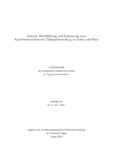Citation link:
http://dx.doi.org/10.25819/ubsi/10499Files in This Item:
| File | Description | Size | Format | |
|---|---|---|---|---|
| Dissertation_Gruen_Arthur.pdf | 37.38 MB | Adobe PDF |  View/Open |
| Dokument Type: | Doctoral Thesis | metadata.dc.title: | Entwurf, Modellbildung und Realisierung einer Asynchronmaschine mit Zahnspulenwicklung im Stator und Rotor | Other Titles: | Design, modeling and realization of an asynchronous machine with single-tooth winding in the stator and rotor | Authors: | Grün, Arthur | Institute: | Department Elektrotechnik - Informatik | Free keywords: | Elektrische Maschinen, Zahnspulenwicklung, Zahnspulenbewickelte Asynchronmaschine, Electrical machines, Toothed coil winding, Tooth coil wound asynchronous machine | Dewey Decimal Classification: | 621.3 Elektrotechnik, Elektronik | GHBS-Clases: | XZU XKK XVWD |
Issue Date: | 2023 | Publish Date: | 2024 | Abstract: | Allgemeines Ziel der vorliegenden Arbeit ist es, einen detaillierten Blick auf eine zahnspulenbewickelte Asynchronmaschine im Stator und Rotor zu werfen. Ein besonderer Schwerpunkt liegt hierbei auf der Betrachtung eines neuartigen, mehrphasigen und zahn- spulenbewickelten Aufbaus des Rotors und der damit einhergehenden Vorteile. Ausgangspunkt für die Auslegung und weitere Betrachtung stellt die klassische analytische Maschinenbetrachtung am Netz dar. Unter Zuhilfenahme der resultierenden Luftspaltgrößen der Durchflutungsverteilung und magnetischen Flussdichte sowie des analytischen Ersatzschaltbildes, welches als Bezug die elektrischen Klemmen der Maschine heranzieht, wird das Maschinenverhalten auf das resultierende Drehmoment allgemein modelliert. Die Aktivteillänge, die bei konstanter Gesamtlänge der Maschine bei der zahnspulenbewickelten Asynchronmaschine deutlich größer ausfallen kann, wird als ein wichtiges Auslegungskriterium aufgezeigt. Zusätzlich wird die elektrische Rotorschaltung, welche einen großen Einfluss auf den resultierenden Drehmomentverlauf der Maschine nimmt, zwischen einer Sternschaltung und einer kurzgeschlossenen Zahnspule unterschieden und deren Vor- und Nachteile herausgearbeitet. Bezugnehmend auf den analytischen Maschinenentwurf werden einige vielversprechende Maschinenauslegungen näher berechnet. Diese werden unter Zuhilfenahme der numerischen Finite-Elemente-Methode im Detail auf ihr Drehmomentverhalten und ihre Drehmomentwelligkeit hin untersucht. Nach diesen Detailberechnungen wird eine vielversprechende Maschinenauslegung ausgewählt und der Entwurf, die Berechnung sowie die Realisierung einer Versuchsmaschine im Detail dokumentiert. Die realisierte Versuchsmaschine wird in wichtigen Betriebspunkten vermessen und die Messergebnisse sowie deren Abweichungen zu den berechneten und simulierten Werten hin diskutiert. Zusätzlich wird die Versuchsmaschine mit zwei Referenzmaschinen, die einen klassischen verteilten Wicklungsaufbau mit Kurzschlussläufer besitzen, theoretisch verglichen. The general objective of the present thesis is to take a detailed look at a tooth wound induction machine in the stator and rotor. Special emphasis is placed on the consideration of a multiphase and tooth wound rotor design and its associated advantages. The starting point for the design and further consideration is the classical analytical machine consideration on the power system. With the help of the resulting air gap values of the magnetomotive force and magnetic flux density as well as the analytical equivalent circuit which uses the electrical terminals of the machine as a reference, the machine behavior is generally modeled on the resulting torque. The length of the active part, which can be significantly greater for a single-tooth winding induction machine if the overall length of the machine is constant, is worked out as an important design criterion. In addition, the connection of the rotor winding, which has a major influence on the resulting torque curve of the machine, is distinguished between a m-phase star connection and a short-circuited toothed coil, and their advantages and disadvantages are worked out. Referring to the identified analytical machine design, some promising machine designs are calculated in more detail. These machine designs are examined in detail for their torque behavior over speed and torque ripple with the aid of the numerical finite element method. After these detailed calculations, a promising machine design was selected and the design, calculation and realization of a prototype machine were documented in detail. The realized prototype machine is measured at important operating points and the measurement results as well as their deviations from the calculated and simulated values are discussed. In addition, the prototype machine is compared theoretically with two reference machines which have a classic distributed winding design with a squirrel-cage rotor. |
DOI: | http://dx.doi.org/10.25819/ubsi/10499 | URN: | urn:nbn:de:hbz:467-27123 | URI: | https://dspace.ub.uni-siegen.de/handle/ubsi/2712 |
| Appears in Collections: | Hochschulschriften |
This item is protected by original copyright |
Page view(s)
262
checked on Nov 28, 2024
Download(s)
53
checked on Nov 28, 2024
Google ScholarTM
Check
Altmetric
Items in DSpace are protected by copyright, with all rights reserved, unless otherwise indicated.

